Purdue Formula SAE
Purdue University and SAE International
Competition Overview: Formula SAE (FSAE) is a Formula 1 style open wheel racing competition organized annually by the Society of Automotive Engineers (SAE) for college teams. Purdue University's Formula SAE team took part in the competition held at Michigan International Speedway where 100+ teams from the US and abroad participate every year. More details of the competition can be found on the official page .
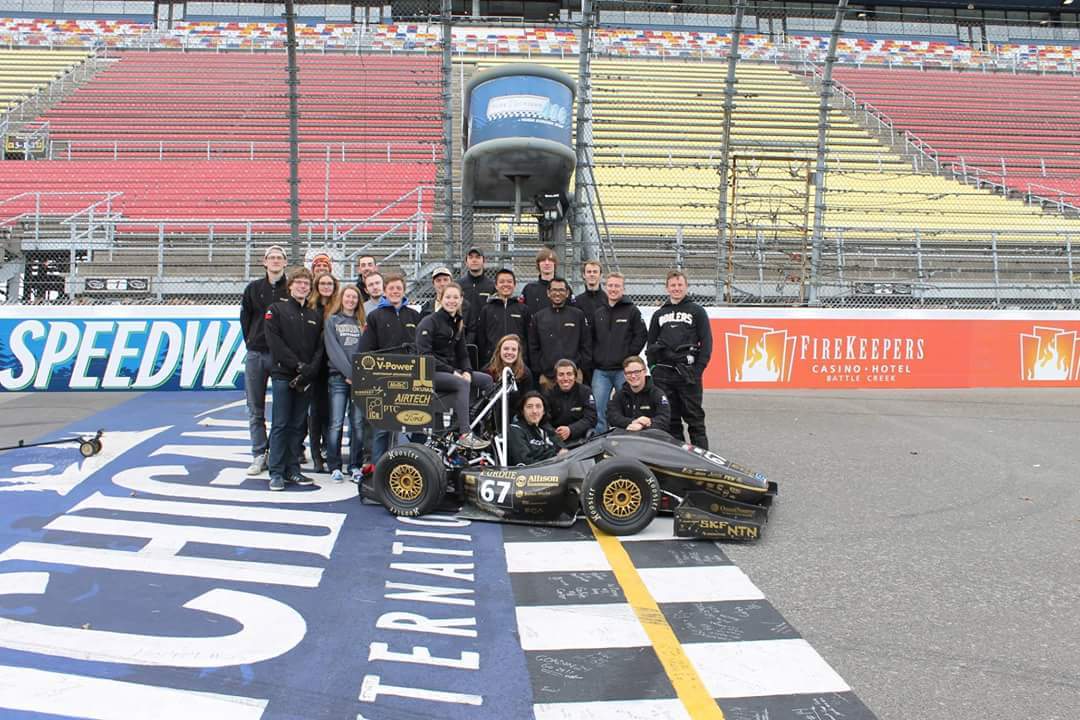
The 2016 Formula SAE car and team at the Formula SAE Michigan 2016
2014-2015 (Sophomore year)
My first year on the team started off with a lot of learning; this was where I first interacted with Computational Fluid
Dynamics (CFD). Most of my tasks were to update previous years' models (CAD and CFD) for the new designs. This was until
I started working on automation. Later in the year, in the build phase, I worked on carbon fiber layups and moulds for these
layups including CAD and CAM. Testing the car was another first time experience that I cherished.
Automating analysis
Once I learnt the basics of CFD, because of my prior experience
with Java, I was assigned the task of automating the analysis using macros for tasks such as rotating the wings and flaps
to determine the change in aerodynamic forces acting of the car. This data was used to set-up the car for testing.
Using this automation we simulated flow over many configurations of the car, changing multiple variables to determine
the effect of one on the other. An example of the kind of data generated can be seen below.

Using automation allowed the team to generate more data points and to determine effects of one variable on another.
2015-2016 (Junior year)
Since CFD simulations take a lot of computing resources, the team's one computer was insufficient for the automated runs of
multiple back-to-back simulations. The continuous runs of simulations also impeded other members' right to the computer.
My goal as a returning member of the team was to find a solution to the problem. I also had to work with new members to
make them active contributing members of the team. My work as an aerodynamicist continued as we constantly experimented with
simulating new design innovations.
Manufacturing was similar, but with more responsibility on me as a returning member.
I took initiative to generate CAM files and to get access to more capable machines in other parts of the campus that we didn't
have access to before.
Supercomputing at Purdue
With my macros, the aerodynamics had taken over the team's
only computer, an Intel i7 processor PC that was far from adequate for 3D CFD simulations. In order to find a solution,
I contacted Purdue RCAC
and worked with RCAC staff and the administration of the Mechanical Engineering department to get the team access to
Radon and Scholar clusters. It quickly became obvious that getting access was the easy part. For the next 3 months, I worked
back and forth with RCAC staff and Star-CCM+ support to start running simulations on the clusters.
By the end of Summer
2015, I had single handedly set-up the Formula SAE accounts on the clusters to run simulations on Star-CCM+ and started
training the other members of the team. Alongside this, I also tried to improve our methods with efforts such
as running simulations in batch mode instead of using a GUI. These efforts generated dividends for me when I worked on the
Delta Wing Research at TU Braunschweig, since that involved working on a Linux interface.

Velocity vector field of flow under the car. The areas behind the wheels were targets for improvement using new supercomputing resources because we could run more simulations and experiment more with ideas.
New member training
The team leader for 2015-16, Brian O'Niell took the responsibility
to deal with the new members, but as the only other returning member, I also contributed significantly to this training. I
taught them how to work with CFD simulations, working with PTC Creo Parametric, FEA Analysis and manufacturing processes. My
major efforts were towards training members in CFD, with the goal of making atleast one CFD enthusiast like me. By the time I
left the team, I could see other members of the team, especially Adam Christopherson, show the same passion for CFD as me.
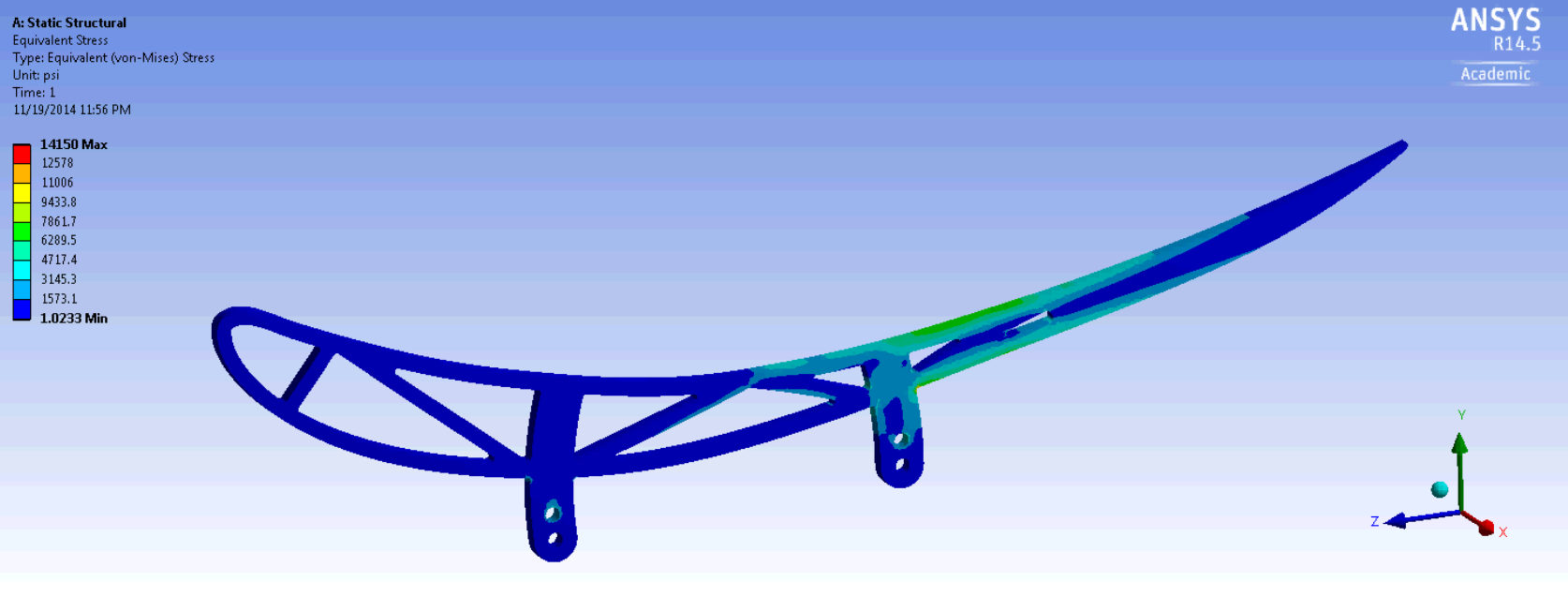
Finite Element Analysis was one of the things that I trained new students in.
CFD consultation with Dr. Tom Shih
While the team seemed to be doing fine this year
despite having only two returning members, both with only one year on the team, it had always been apparent to me that there
was room for improvement in our CFD techniques. In order to fill in some deficiencies and to improve my knowledge on the
subject, I approached
Dr. Tom Shih, Head of the Aeronautics and Astronautics department at Purdue University and a professor for CFD classes.
Dr. Shih graciously agreed to help me, enrolling me in a 1 credit hour AAE 490 class, and gave me an hour of his time every
week, despite his busy schedule. While I did learn some new techniques and gained some knowledge on how to judge the quality
of a simulation, the most important lesson for me was how to present the results of a CFD study. I shared my knowledge with
the team and later as team leader, made sure that simulations were of good quality and presented well.
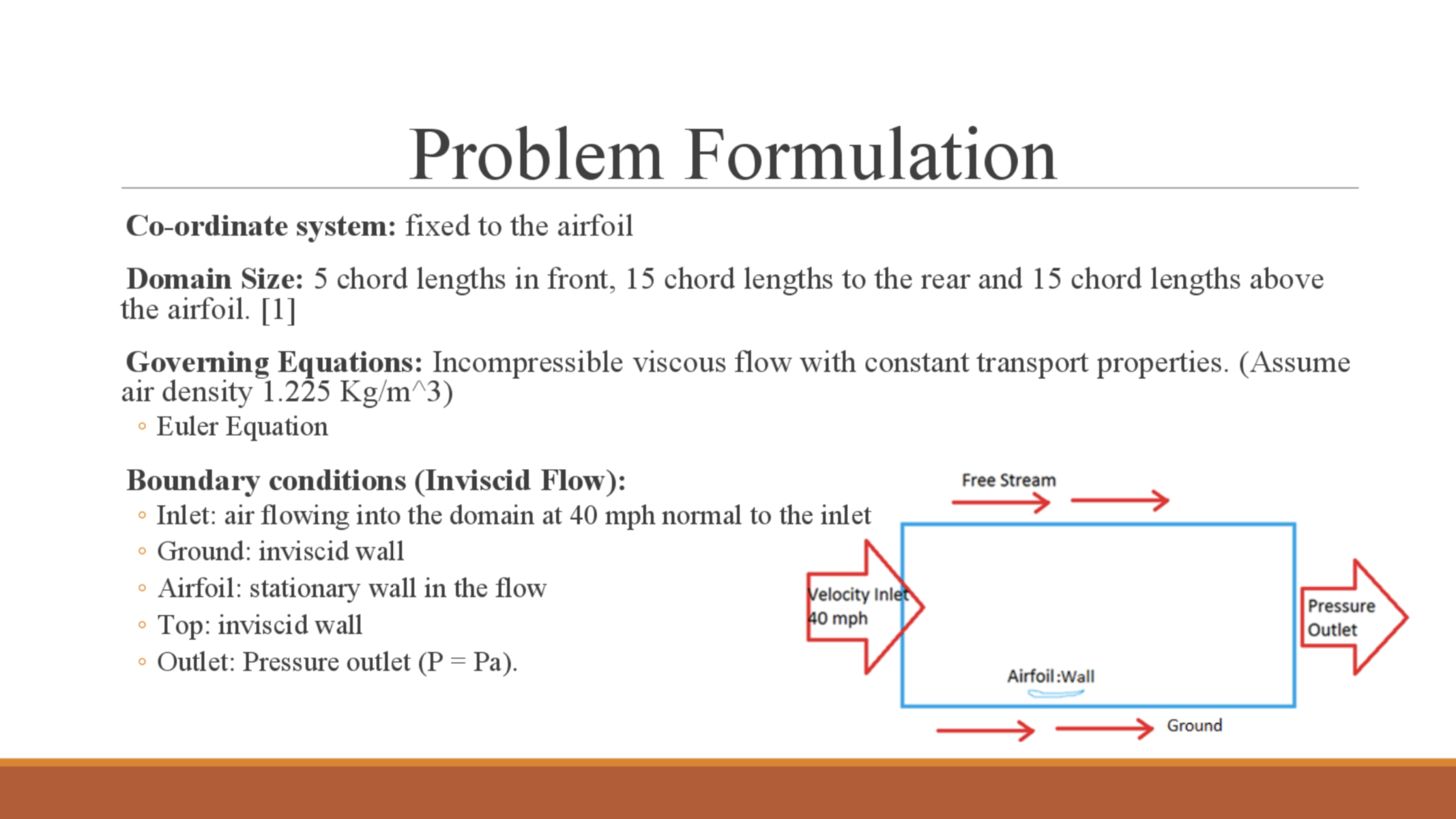
Dr. Shih taught me how to present results of a CFD study. He taught me that the presentation is as important as the study itself.
2016-2017 (Senior year/Aerodynamics Team Leader)
Thanks to the previous team leader, Brian O'neill, we had amazing new member retention from the previous year and at the same
time I was graduating early and wouldn't be with the team for the entire year. Due to these factors, I took on a managerial
role in the team.
Aerodynamics Team Leader
As team leader, I divided tasks amongst the members, set goals and deadlines, resolved design conflicts, and worked with other
sub-teams to maintain design harmony with the rest of the car. One of my major goals was to make the aerodynamics
team more competent than the team I had joined, and the second major goal was to put the team in a direction where they can
clean up the aerodynamics and generate better performance in the future.
To meet the first goal, I constantly pushed the members to brainstorm and improve their methods. A lasting change has been the
introduction of Optimization Algorithms to solve design problems, talked about below.
To meet the second goal, we would either start design from scratch for existing components, or take inspiration from Formula 1.
Two design changes that I was actively involved with, and that had an impact, were using a barge board for the sidepods and
using turning vanes to reduce separation of flow in the undertray due to the rear wheel.
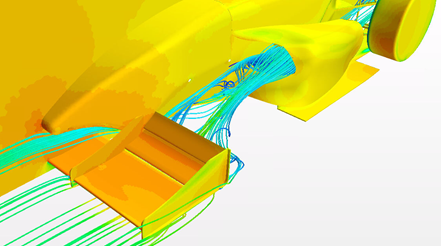
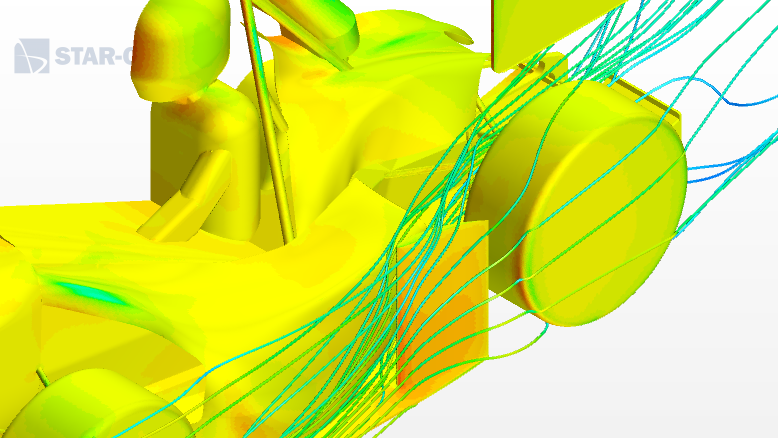
Bargeboard (left) and Turning Vane (right) were aerodynamic devices employed to improve flow characteristics around the car.
This was very much a learning experience for me and I did hit many hurdles, some of which, in hindsight, I could have dealt
with better. But this was my first experience in a leadership position and I enjoyed it while also taking away many lessons.
Optimization Algorithms
In order to improve the design process, I consulted
Prof. Dan DeLaurentis (Dr. D) about how to solve multi-variate design problems (such as multi-element wings)
to find the best (optimal) solution in the shortest amount of time. He recommended that we use optimization algorithms, and referred me
to a graduate student of his who could help us getting started up. I assigned Adam to the task of implementing this technique
for the front wing elements using 2D simulations. This was a major success as the new design generated 15% more downforce than
previous year's. While I did not implement Optimization Algorithm myself, interacting with the graduate student and talking to
Adam gave me a sense of how these algorithms work. I often worked with Adam on troubleshooting and that improved my understanding
of the code. Despite this I have a lot more to learn on the subject and this is one of the areas I hope to work on in the future.
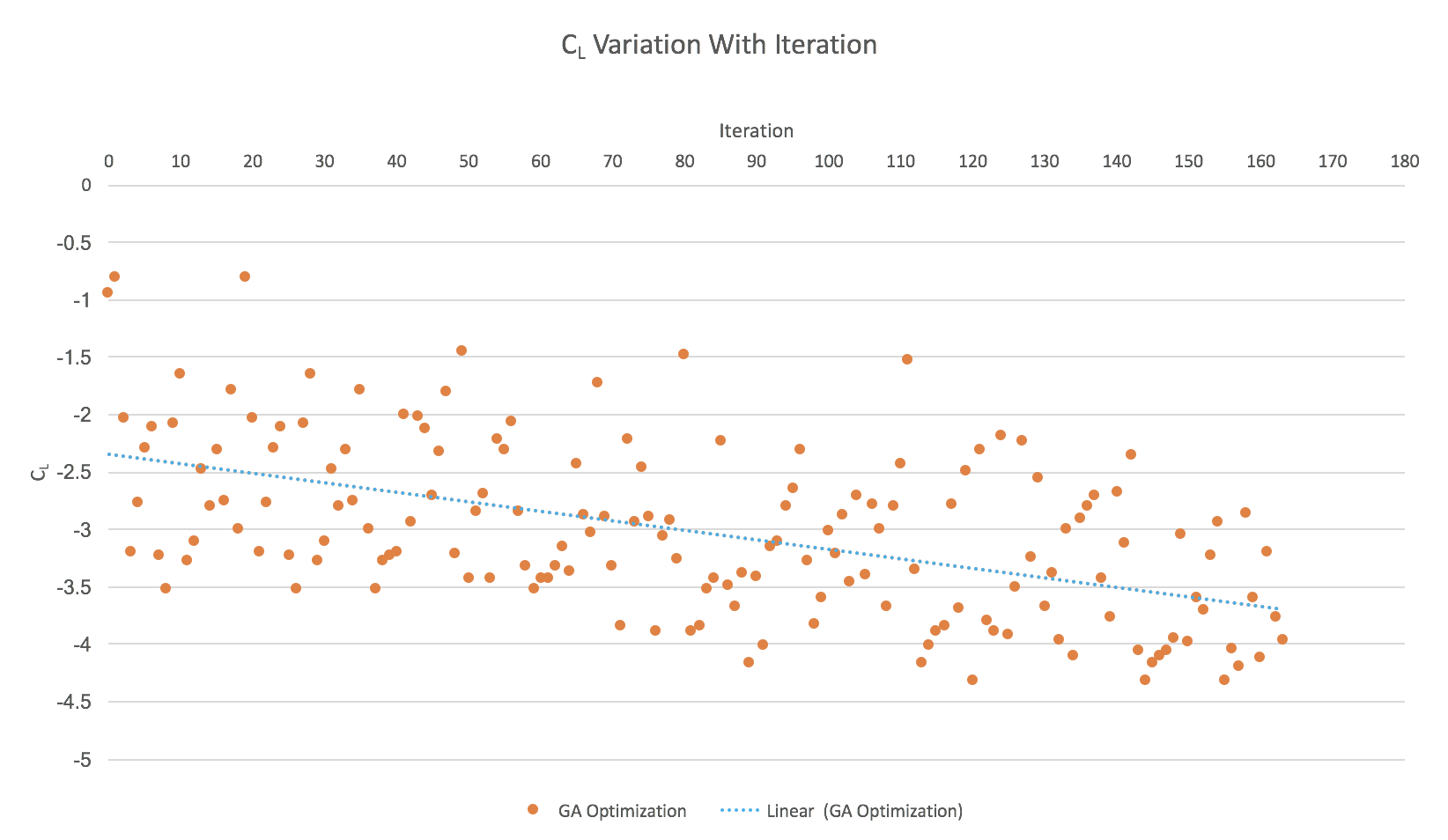
Results of every iteration of the optimization result clearly show a trend of increasing downforce (negative lift)
Wind Tunnel Testing
Another major boost to the aerodynamics team was that, thanks to
efforts of Jon Bruce, we had received sponsorship from Ford Motor Company to use a Wind Tunnel at their Driveability Test
Facility. As the team leader, it was my responsibility to co-ordinate with the managers of the facility and to plan out the test
in order to make the most of this opportunity. I consulted Naveed Rahman, a graduate student at Purdue who had experience with
planning such tests. One of the drafts of the plan I made can be viewed here. While I did not
go for the test day due to exams, I was told that the test was a success and this was greatly satisfying to me.
Being a member of Purdue Formula SAE was one of the most fulfilling experiences I had at Purdue. When the car would start for the first time, or perform well in a competition, the surge of happiness and pride were unmatched and I long to have the same feeling with new projects all my life. At FSAE I gained experience in almost all aspects of engineering, from design and manufacturing to leadership and management. I hope to contribute to world changing projects in the real world in a similar manner in the future.
Testimonials
I had the pleasure of working with Ujjwal on Purdue's Formula SAE team. He was an extremely intelligent
and hardworking team member. He was proactive enough to contact me about joining the team before we began
recruiting for the semester. He was a fast learner that quickly became proficient in performing CFD analysis
in STAR-CCM+. With little direction, he implemented macros to automate our analysis process, greatly
increasing the number of design iterations we could perform. After the design phase, Ujjwal was willing
to spend many long hours in the shop helping with the manufacturing and assembly of the car. During
testing and competition, he was there to provide track-side support to ensure the car's successful
performance. After I graduated, he took our lessons learned and went on to improve the team even further.
This included offloading CFD analysis onto clusters, integrating optimization algorithms into the design
process, improving new-member retention with better recruiting/training, setting up alumni design
reviews, etc. Ujjwal is an excellent engineer that would be a valuable addition to any organization.
-Liangchun (Jimmy) Chen, Aerodynamics Team Leader (2014-15)
Ujjwal was a pleasure to work with on Formula SAE. He definitely has a strong grasp on
aerodynamic theory and has CFD experience to match. Ujjwal got me really excited about using CFD by showing some
of its capabilities and teaching me advanced concepts. I appreciated his ability to apply his extensive knowledge
in practical design applications as well. Ujjwal made some outstanding and lasting contributions not only to our
Formula SAE components, but also our design methodology and autonomy. We miss having him on our team.
-Adam Christopherson, Teammate and co-Team leader, Aerodynamics (2016-17)